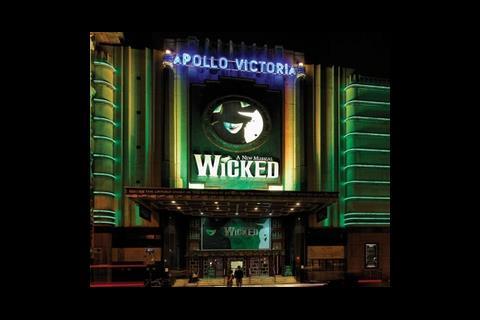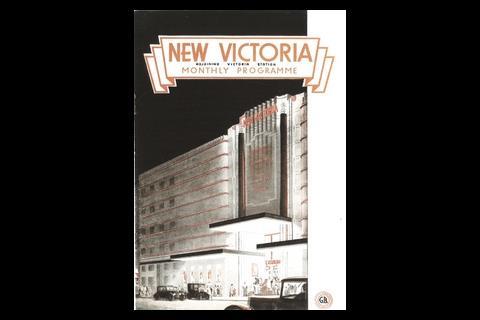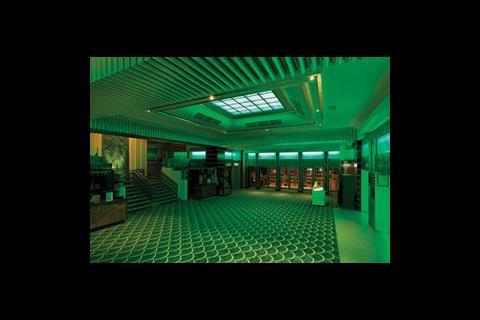After more than 70 years, thanks to modern lighting technology, the Apollo Victoria in London has been restored in line with the wishes of its 1929 architect. BSj reports
It’s taken 70 years and a several major leaps in technology but finally the Apollo Victoria Theatre in London has got the façade its original creator always desired.
The realisation has come about following Hoare Lea Lighting’s appointment by architects Jaques Muir and Partners (acting for Live Nation) to design the feature foyer and façade lighting for the Grade II listed theatre. The brief was to restore the art deco building as accurately as possible to the original architect – Ernest Wamsley Lewis’ – intent. While respecting the 1929 design, the team, headed by Dominic Meyrick, also wanted to add a contemporary twist. Having previously designed and implemented the lighting installation for the main auditorium using colour changing LEDs, the perfect solution was to complete the outstanding areas using the same light source, therefore harmonising the scheme.
“Respecting the original architectural design was a priority for the exterior lighting,” says Juan Ferrari of Hoare Lea Lighting. In an interview in 1973, Wamsley Lewis had expressed his wish to incorporate bands of green lighting into the original facade. This never reached fruition, however, as the electrical engineer at the time encountered technical problems – although the horizontal bars housing slots for lighting were installed, indicating the correct position for the linear lighting treatment on the façade. “A 1936 programme also featured an illustration showing an amber light but this seems to be purely speculative,” adds Ferrari.
With the advances in technology Hoare Lea Lighting felt sure they could finally realise Wamsley Lewis’ ambition. The obvious choice was cold cathode lighting (a close relative of neon) – Hoare Lea Lighting, however, was convinced that the power consumption, durability and colour choice of cold cathode could be bettered.
Hoare Lea Lighting, with LED manufacturer NJO, developed a fitting with similar characteristics to cold cathode, but with the advantages of colour changing and energy efficiency. The result is a stunning design which incorporates the flexibility to enable the lighting to support the promotion of the current production – Wicked – and a variety of future shows.
Bringing the foyer alive
The foyer was the other major part of the restoration process. Here, the laylight has been re-installed as the central ceiling feature, as well as the clerestory window frames that run around the top of the foyer walls. These were originally made of framed opal glass, backlit with GLS lamps to create the illusion of daylight penetrating from above through the windows of a secret underwater palace.
To replace this system Hoare Lea designed an LED lightbox, which was installed behind the new clerestory glass panels. Linear LED fittings and reflector backing panels were made to custom lengths and angled individually for each faux clerestory window to achieve the optimum light spread and intensity over the opal glass. The central glass laylight feature was also backlit with a suspended set of linear LED fittings, while the bar area was highlighted with LED fittings concealed within the architectural finishes.
The finished scheme demonstrates that LEDs were the ideal light source for this application. Not only does the completed foyer installation match the original intent in terms of visual impression, the LEDs also add a whole new dimension to the space by allowing colour-mixing capabilities and Digital multiplex control, not to mention high output, low running cost and long lamp life.
Together the refurbishment of the façade and foyer lighting has added the finishing touches to one of London’s most impressive theatres. “These solutions would have been impossible to achieve in 1930. However, we like to think that, had Ernest Wamsley Lewis had the tools we have at our disposal, his scheme would have been similar to our own,” says Ferrari.

The auditorium lighting in the Grade II listed theatre was replaced in an earlier refurbishment undertaken by Hoare Lea Lighting in 2002. Again, LEDs were used extensively. As Dominic Meyrick, lighting principal, explains “The 1929 auditorium design incorporated 3500 GLS lamps in two colours (aquamarine and amber) on two circuits that could be faded to give the illusion of an underwater palace. The lighting layout became unusable due to high maintenance.”
The solution was to replace these high output, colour-mixing LEDs – 987 fixtures (83 895 LEDs in total) in 160 controllable groups using 643 DMX channels. Each group has four channels: red, green, blue and dimmer. This takes advantage of the ‘effects’ engine in standard theatre desks
Source
Building Sustainable Design

























No comments yet